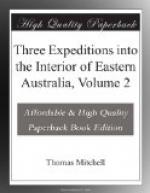WE AT LENGTH EMERGE ON MUCH FIRMER GROUND.
For several miles we met with soft ground at the low connecting parts of hills, but we at length gained the woody ridge so likely, as I had hoped, to favour our progress. Its turnings were intricate but, by one or two rivulets falling to my left and then by others falling to the right, I learnt how to keep on the intermediate ground until at length, after a journey of nine miles, we emerged from the woods on a firm open surface and an extensive prospect was seen before us. Leaving the party to encamp I rode to a round forest hill some miles to the eastward and obtained a comprehensive view of the Grampians, and also of the country to the northward which now appeared to be chiefly open; and I had little doubt that we should find it more favourable for travelling upon. Eastward of the forest hill the ground sank into a deep valley which turned round to the south-east after receiving the drainage from some hollows in the open country north of it.
RIVER HOPKINS.
This ravine received also the waters from the woody ridge now south of us, where the numerous deep valleys were irrigated by streams arising in swamps; the whole probably forming the head of some more important stream flowing to the coast and which I here named the river Hopkins. This eminence, which I distinguished as Mount Stavely, consisted apparently of decomposed clay-stone or felspar, having a tendency to divide naturally into regular prisms. A very beautiful and singular-looking shrub appeared on the hills we crossed this day, and also on the open ground where indeed it was most abundant. It was a species of acacia, the leaves adhering edgeways to thorny branches; many of these shrubs were in blossom, the flowers being yellow and as large and round as marbles, and those growing very thickly, they gave to the branches the appearance of garlands or festoons, the effect altogether being extremely graceful and singular. We found also a beautiful new species of acacia looking like a broad-leaved variety of A. armata. The branches were singularly protected by short spiny forks which proved to be the hardened permanent stipules.*
(Footnote. A. furcifera, Lindley manuscripts; stipulis spinescentibus persistentibus, phyllodiis obliquis ovato-oblongis mucronatis uninerviis hinc venosis glabris, ramis hirsutis, capitulis solitariis foliis brevioribus.)
With this occurred another species with hard stiff scymetar-shaped leaves and a profusion of balls of browner yellow flowers which had been previously observed (on June 22) in a more vigorous condition.* By observations from this hill I made the height of Mount William about 4,500 feet above the sea.
(Footnote. This was most nearly related to A. hispidula, but the leaves were quite smooth and much smaller. A. acinacea, Lindley manuscripts; glaberrima; ramulis alato-angulatis rigidis, phyllodiis brevibus acinaciformibus mucronatis 1-nerviis et enerviis: margine superiore infra medium glanduloso, capitulis geminis axillaribus, pedunculis phyllodiorum longitudine.)




